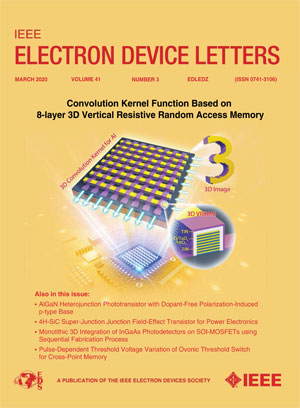Improved Memory Performance Through Integration of Ferroelectric and Ovonic Threshold Switching Layer
IF 4.1
2区 工程技术
Q2 ENGINEERING, ELECTRICAL & ELECTRONIC
引用次数: 0
Abstract
In this study, we explore the combined effects of a ferroelectric (FE) layer with an ovonic threshold switching (OTS) layer to enhance the performance of memory devices. Initially, to enlarge memory window, an FE layer was used to induce bidirectional shifts in the threshold voltage (V通过铁电和卵形阈值交换层的集成提高存储器性能
在本研究中,我们探讨了铁电(FE)层和卵泡阈值开关(OTS)层的联合作用,以提高存储器件的性能。最初,为了扩大存储窗口,使用FE层诱导OTS的阈值电压(V $_{\text {th}}\text{)}$的双向移位。与不施加极化场的情况相比,这种极化诱导调制导致了额外的存储窗口。随后,为了提高可靠性,利用FE层的持久场来减轻OTS层的有效电场。该极化场作为一种附加脉冲方案,从而减少了陷阱的弛豫效应,改善了漂移。最后,我们的发现证明了FE层能够通过可调节的极化和大的存储窗口来促进多级状态。我们还研究了与基于硒的选择器存储器(SOM)器件的集成,在那里我们观察到存储器窗口的显着增强,超过2 V。这些发现表明,通过战略性地整合FE和OTS层,可以显著改善SOM。
本文章由计算机程序翻译,如有差异,请以英文原文为准。
求助全文
约1分钟内获得全文
求助全文
来源期刊

IEEE Electron Device Letters
工程技术-工程:电子与电气
CiteScore
8.20
自引率
10.20%
发文量
551
审稿时长
1.4 months
期刊介绍:
IEEE Electron Device Letters publishes original and significant contributions relating to the theory, modeling, design, performance and reliability of electron and ion integrated circuit devices and interconnects, involving insulators, metals, organic materials, micro-plasmas, semiconductors, quantum-effect structures, vacuum devices, and emerging materials with applications in bioelectronics, biomedical electronics, computation, communications, displays, microelectromechanics, imaging, micro-actuators, nanoelectronics, optoelectronics, photovoltaics, power ICs and micro-sensors.
 求助内容:
求助内容: 应助结果提醒方式:
应助结果提醒方式:


